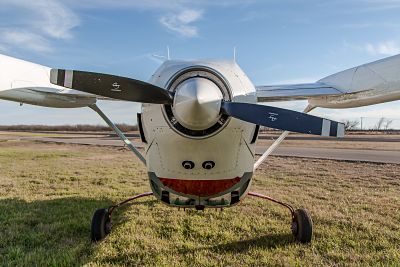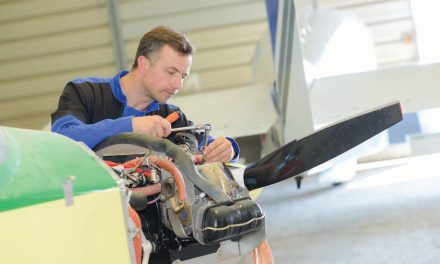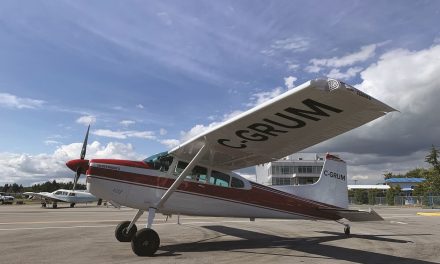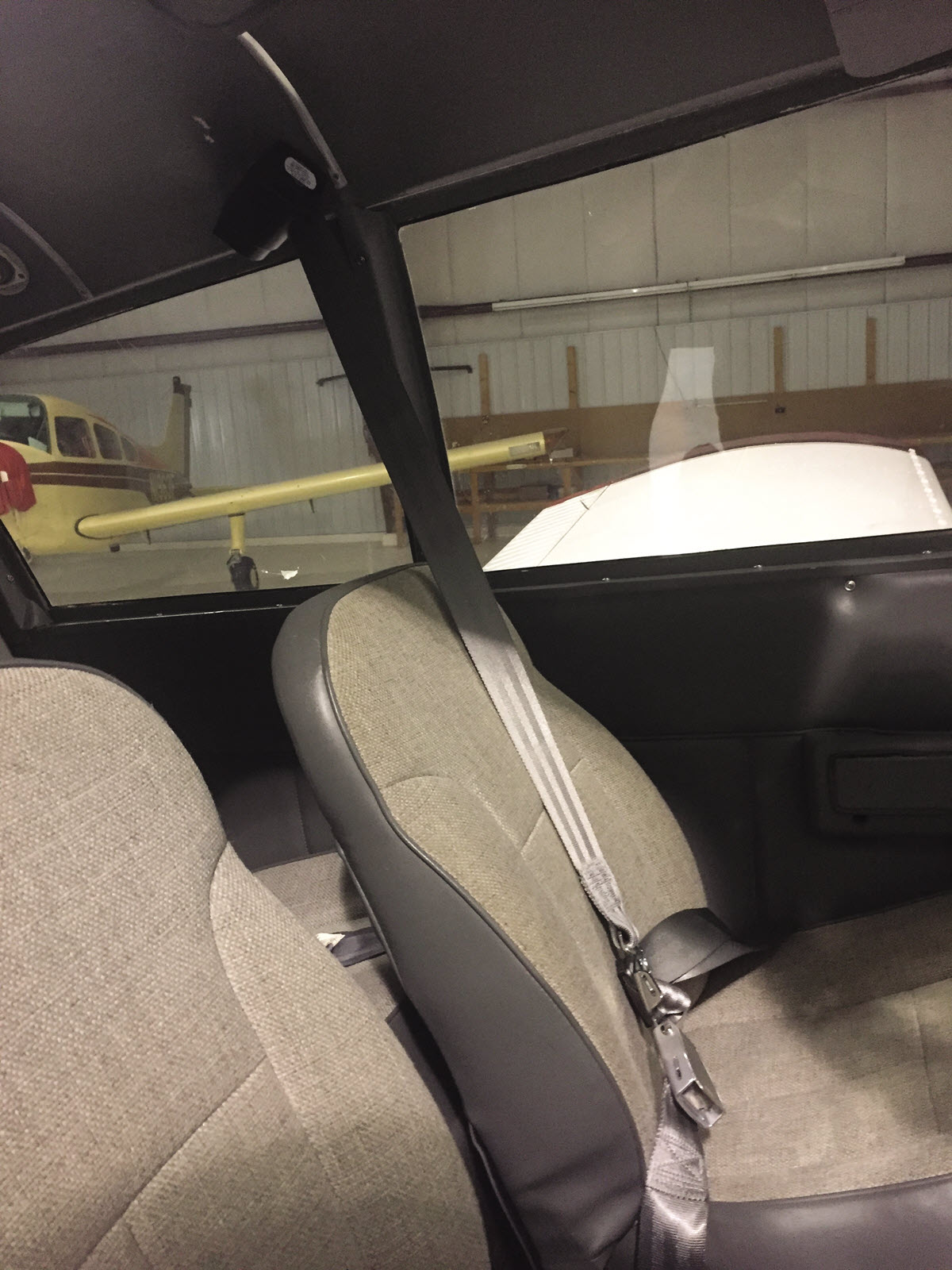By Jim Cavanagh
When you build or make anything, most of the time the real work goes unnoticed. You can labor for years to complete something and the paint gets all the attention. Sounds unfair, but the reality is that the gleam, the shine, the form draws the eye. Indeed, it is the finishing touches that are the icing on the cake. The attention to detail to make something pull together into the final form is a concept that cannot be ignored.
With airplanes, anyone looking at one will be drawn to the flow of the lines. Is the windshield streamlined or like a big block of plastic set on the cowling? Does the airplane look like it is flying while on the ground? Does it look like it wants to fly? Most taildraggers have an aggressiveness, pointed toward the sky like that is where it should be. But nothing, in my personal opinion makes an airplane seem more complete or perfect than the spinner!
For the love of spinners
I have always loved the form of spinners. When I first started going to Oshkosh 42 years ago, I started taking pictures of spinners. I loved the giant, washtub sized spinners on the warbirds. I like the way that the spinner design pulled the eye along its form to the cowling and how the cowling meshed into the fuselage on planes like the Mustang, the Focke-Wulf, the P-47.
When I began looking at the homebuilts, especially some of the elongated funnel-shaped spinners on taildraggers, they looked so fancy like they absolutely had to create some sort of performance increase. Some guys on forums say that a spinner on a pusher prop has to be quite elongated to be effective, creating a nice linear airflow. Others question the actual effectiveness of this installation as the air is being impressively disturbed by the propeller blades. A spinner on a pusher engine may not do much except add to the aesthetics. A spinner on a tractor prop, however, is another matter.
Spinners up front are designed to be aerodynamic as well as aesthetic. They are protective and contain all of the attachment hardware and the working parts of constant speed, electric and variable-pitch props. This includes counterweights on some models. The spinner is an important part of the cooling of the airplane, allowing air molecules to slide down the form and into the cowling holes. Air hitting a flat prop hub and bolts will go wherever it wants. Some propeller designs require a long spacer to push the prop out into undisturbed air and allowing the air to transition smoothly into the prop blades with no back pressure from a cowling.
Note the prop/cowlings on older Piper Cherokees. Other, usually older, designs do not require this. While an airplane will fly without a spinner, cooling will be affected, plus it could be illegal. Many airplanes, and probably all the models built after the ’60s, probably have the propeller on the Type Certificate Data sheet as required equipment.
A spinner is actually an assembly that includes bulkheads. Some are for fastening, others are for preloading, putting a resistance force on the dome. The dome needs to be preloaded because the fasteners need to be very, very snug. Any space surrounding a fastener can allow movement, and any movement in a spinner is exacerbated by its turning with the crankshaft. Engine pulses, balance, even the localized hardness of the metal can cause cracks.
Types of spinners
On a fixed-pitch prop, the main bulkhead usually has holes to match the crankshaft flange, and usually one of these is a tiny bit larger to help “key” the propeller. This needs to be installed correctly to avoid damage to the bulkhead and to allow the propeller to be mounted correctly – one blade at the 10 o’clock position with the engine at Top Dead Center (TDC) on #1 cylinder. The bulkhead normally slips onto the crank flange, then the prop, and then the secondary, preload bulkhead, finally bolts through all parts into the crank flange. These are then torqued and then safety wired. Adjustable pitch props are similar however the preload bulkhead may be attached to a flange built into the prop assembly.
I’m sure you have seen the “skull cap” spinners used on some of the classic aircraft like Cubs and Champs, etc. These basically cover the prop attach bolts and safety wire and (if the prop is wood) the crush plate. A simple welded flange and one screw holds these on, and they are basically cosmetic.
Wooden props have special requirements because of the nature of the wood and meteorological/climate changes. Sensenich puts out installation and maintenance procedures that MUST be followed. I experienced this personally when young and foolish!
When installing the dome, a good preload rule of thumb is that the mounting holes of the dome only cover about half of the nut plate holes. Pushing in on the spinner should load the dome and line up the holes. Some guys use tape around the front bulkhead flange as shim material to provide good contact.
What will happen is the spinner will over time begin to wobble, but don’t worry, this won’t last long. The spinner will soon depart the airplane. This happened to me once, flying a 150-hp Grumman Yankee from Mexico, Missouri, to Kansas City. Very nice sunset going of off my nose, and I started seeing little silvery specs and suddenly a bang and a dark blob flew up over the canopy. I had just had the prop/engine dynamically balanced and later found that the tech had incorrectly installed balancing washers. That is when I learned that spinners aren’t cheap!
When I decided to write this piece, I looked for and found a metal spinning company in town. Actually, two. I had always thought that the airplane manufacturers built their own spinners, but many companies farm this out to spinning companies. These aerodynamic domes and some bulkheads are manufactured by spinning, rather than stamping, as the process is much easier, creates a smaller, lighter, stronger part by realigning the grain structure, and the process is relatively quick and cheap, compared to other methods.
Spun parts are axially symmetrical and seamless, allowing the use of lighter materials. Any ductile metal sheet can be spun into shape, including steel, stainless, copper and gold!
United Metal Spinning
United Metal Spinning has been in Kansas City for 90 years. UMS makes anything from chalices and incense burners for churches to lighting fixture reflectors, to scuba tanks to, well, spinners! They also have a line of high-quality, stainless steel cookware that they sell to restaurants.
The company has a number of spinning lathes, as opposed to wood lathes that are used by carpenters and turners, that can make parts from an inch up to 100 inches in diameter. Larry Brenneman Sr., was my host. He is the third generation Brenneman at UMS, and his son is the fourth, and HIS son is the fifth. Mrs. B is also there, a delightful addition who keeps things in line!
The first thing I noticed when I walked in was a full-sized Captain America Shield! Brenneman told us they have made all of the shield blanks for the Marvel movies. This kid at heart was impressed!
We started a walkthrough of the shop – a large, well-lighted room full of shelves with tooling, prototypes and one-off parts. The company will do these one-offs, and some of their business, besides antique classic aircraft stuff, includes hubcaps for classic cars, popcorn machines, religious appliances, signs, sculptures, actually anything that spinning can create.
The process starts with a block, which is usually a round wooden form of a given thickness. These are made by a company in Wisconsin, with many sizes in inventory but all sizes available. Bell cowlings for Waco aircraft, for example, require a forming tool of about a foot deep by 60 inches in diameter. UMS will turn this block to the desired shape and size and then will use it for hand forming a sheet of aluminum, usually half hard, which is rigid, yet malleable when in motion. Chucked into the lathe, the metal man uses a series of forming rods of different shapes and an adjustable fulcrum tool to shape the metal to the form. In a couple of minutes, Larry Jr. fabricated a cup with a beaded rim out of a flat 6-inch disc of aluminum.
UMS prefers to make all its parts by hand. It has CNC equipment, but reports that the parts somehow are much smoother and have a better finish when hand-fabricated. It is the personal touch, the “art” of turning, that does this. I asked if the larger parts require more than one worker, and was told that once the metal is moving, it takes very little force to cause it to “flow” in the direction it needs to go. Women did this work during WWII.
The different sized lathes turn at different speeds. The large one turns 1000 rpm at the spindle, so it cold be four times this speed at the edge of a 100-inch piece.
I was surprised at how much aviation work the company did. Aerodrome Aircraft, Rob Bosley’s company that designs and builds WWI replicas (the movie “Flyboys”) has all of his work done here, including spinners and the bell cowlings for the radial engine models. Hummel Aircraft has all of their spinners built here, as does Waco, for both spinners and bell cowls. One of the shelves in the shop is all aviation spinner blanks, and I asked about how many manufacturers he contracted to. Actually, he does a lot of custom work for the “little guys.” Of the 11,000 Japanese Zeros built, there are only two remaining, one owned by the Commemorative Air Force, and one by Planes of Fame, in Chino, California. Both have cowlings and spinners built by UMS.
Serious spinner considerations
A motivated builder will need to pay for the making of the tool and the actual fabrication. The former is the big cost as the tooling must be fairly precise. Builders of classic cars, one of a kind aircraft or other items will absorb this cost as the total price of the object may be … “serious”!
Metal spinners suffer from a couple of problems. They can crack and the holes for fasteners can erode. Both can lead to ultimate failure. Holes can be fixed as simply as using Tinnerman washers, but many shops will weld them up, planish and re-drill. While traditionally it is thought that you cannot weld a spinner, you actually can, however how long it will last is a great unknown. You have to know the material the spinner is made of. That is usually in the materials list of your maintenance or parts manual.
A spinner gets sort of work hardened from all of the pulses and vibrations being absorbed by the metal. This makes the material stronger, to a point, and lessens its ductility. Eventually, like bending a copper or steel wire, the metal will crack. Because of the stresses and the pathways within the metal, you never know where the crack will occur or how large it will be.
There are shops that advertise that they have approved weld repairs. ASEI is one, Beegles in Colorado another, and Precision Aircraft Welding for a third. I would imagine that to get a good finished product one would have to anneal the part, weld the crack, planish it flat if it is weldable aluminum (6061, 5052 or 3003) and then may anneal so it would not be as brittle.
Guys who want a polished look are in for a lot of work, first eliminating spinning marks and then polishing to a mirror finish. No, you do not chrome a spinner! All that shine is elbow grease.
Taking Care of Business
A company called TCB Composites has been refining composite spinners and bulkheads for 20 years. TCB stands for Taking Care of Business and is a Kihomac company. They have an inventory of Piper, Cessna, and Grumman spinner assemblies, and will do one-offs for an owner if there are a lot of airplanes like his.
TCB’s products are carbon fiber and are quite nice. Their bulkheads are seven layers of carbon fiber and are tested to 4000 rpm. A new product is a chromed spinner that looks like glass! Saw one on display at SUN ’n FUN and was very impressed. The spinner is shipped to the owner who sends it to Paul’s Chrome Plating in Evans, Pennsylvania, for chroming. The two companies developed the process and you can see the results in the pictures. It is not cheap, but it is gorgeous!
An owner might consider replacing the factory spinner screws with SS screws. Usually they are 10-32 Truss head. Make sure they are all the same length and I personally use a high-quality nylon washer to avoid marring the paint. A good trick is to run each screw into a 10-32 die to ensure uniform size. SS screws will bind when you screw them into the steel nut plate if they are just a bit large and get too hot. A shot of WD-40 helps. Use an adjustable torque driver. SS heads strip easily.
Yeah, even though they look like helmets in a Monty Python movie, spinners are important for an airplane for more than just looks. But looks do count. Take your spinner off and look at your airplane. Not the same!






